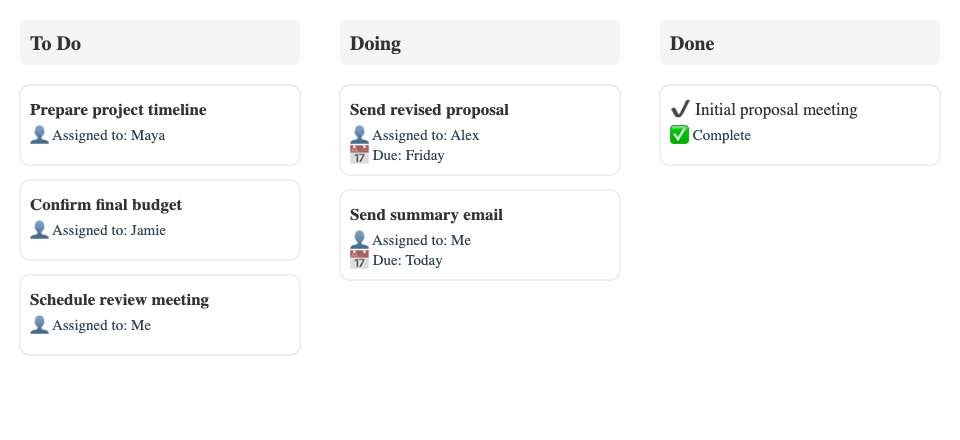Effective follow-up means transforming your meeting notes into clear, actionable summaries that keep everyone aligned.
These polished notes should be:
- Concise
- Accurate
- Sent out promptly
Focus on documenting specific decisions, assigned tasks, and deadlines rather than vague summaries.
For instance, instead of writing "Discussed budget," be specific: "Action: Mei to send revised budget by Friday. Decision: Move forward with vendor B for phase one." This clarity ensures everyone knows exactly what's expected and what comes next.
When sending out your notes, start with a warm, professional greeting that sets a positive tone. Something like "Thank you for attending today's project proposal meeting. Please find a summary and next steps below" keeps your communication friendly yet professional, and shows that you value everyone's time and participation in moving things forward.
Once action items are assigned, your job is to keep them visible and moving forward. Use tools like shared task trackers, project management platforms, or friendly email reminders to make sure nothing gets forgotten. A helpful, proactive reminder might sound like: "Just a quick reminder that the revised budget is due for review by end of day Friday. Please let me know if you need any support." This approach keeps things on track while showing you're there to help, not just monitor.
Some task trackers that could be used to help keep the project on-task and also shareable to the team include tools such as Asana and Trello. Below is an image that shows some tasks that you could put in Asana to track actionable items after a meeting:

In meetings, not every question gets answered and sometimes new ones come up afterward. To make sure nothing slips through the cracks, use a "parking lot" section in your meeting notes — a dedicated spot to capture questions, ideas, or topics that couldn’t be addressed during the meeting.
After the meeting, review the parking lot and make sure each item gets the attention it needs. For example, if a question about the project timeline lands in the parking lot, you might follow up with: "Parking Lot Item: Project timeline—Action: Jake to confirm final timeline with Chris and update the team by tomorrow." This way, everyone knows what’s outstanding and who’s following up.
If someone missed the meeting or needs clarification on a parking lot item, reach out directly or connect them with the right person. For instance: "I noticed your question about the project timeline was added to the parking lot. I’ll follow up with the project manager and get back to you by tomorrow." This shows you’re paying attention and helps everyone feel supported.
It’s also important to encourage ongoing feedback by inviting participants to review the parking lot section and share any additional thoughts or concerns. A simple closing line like "If you have any further questions or notice anything in the parking lot that needs attention, please let me know and I'll make sure it gets addressed" keeps communication open and shows you're there to help.
Here’s a realistic example of how these follow-up skills come to life in a professional setting:
- Jake: Hi Victoria, thanks for joining the meeting earlier. I’ve just sent out the notes—please let me know if I missed anything important.
- Victoria: Thanks, Jake. The notes look great. I did have a question about the timeline for the vendor selection—was that finalized?
- Jake: Good catch. The team agreed to finalize the vendor by next Wednesday, but I’ll double-check with Chris and confirm for you.
- Victoria: Perfect, I appreciate you following up. Let me know if you need anything from my end.
In this exchange, Jake demonstrates clear communication, proactive clarification, and a collaborative tone. He not only shares the meeting notes promptly but also addresses an outstanding question and commits to following up, ensuring Victoria feels supported and informed.
By mastering these follow-up techniques, you'll become the reliable support that keeps your executive and team organized, accountable, and ready to achieve great results after every meeting. Up next, you'll get to practice these skills in tasks that will help you feel confident putting everything you've learned into action.
